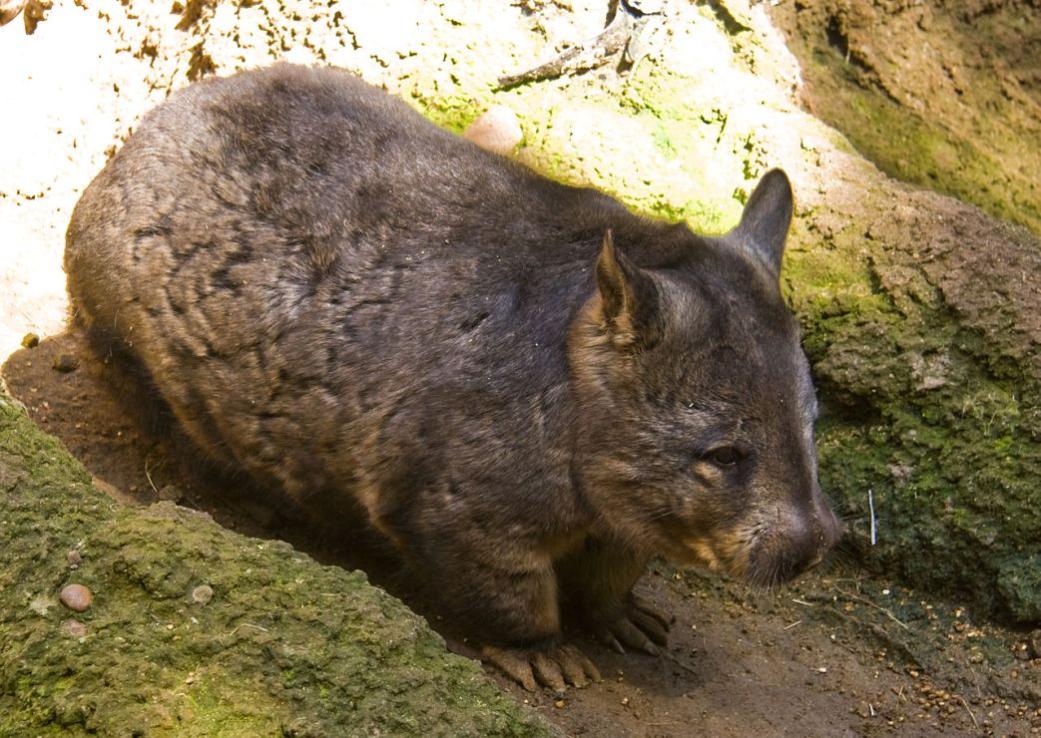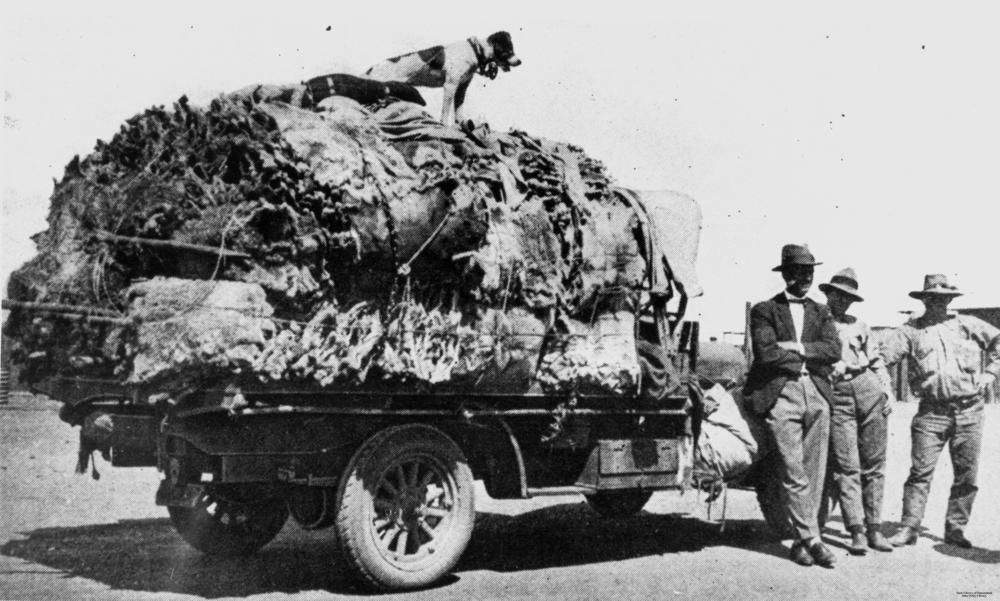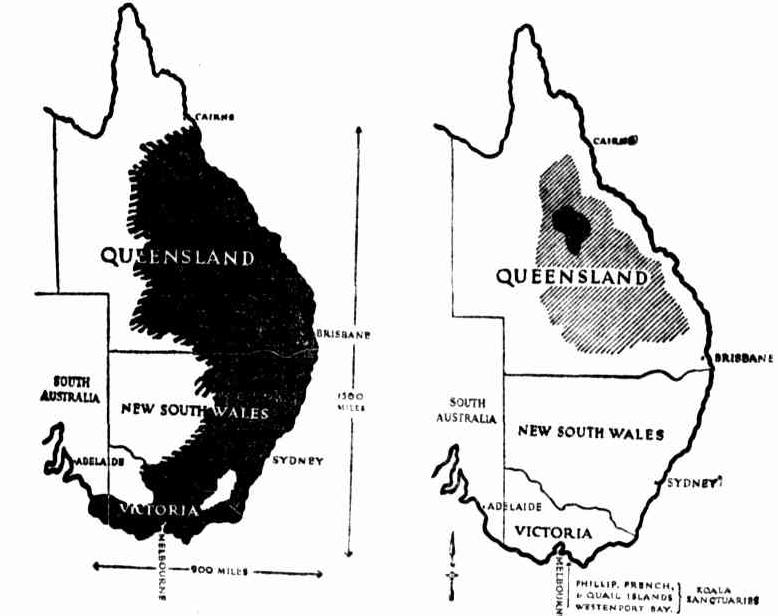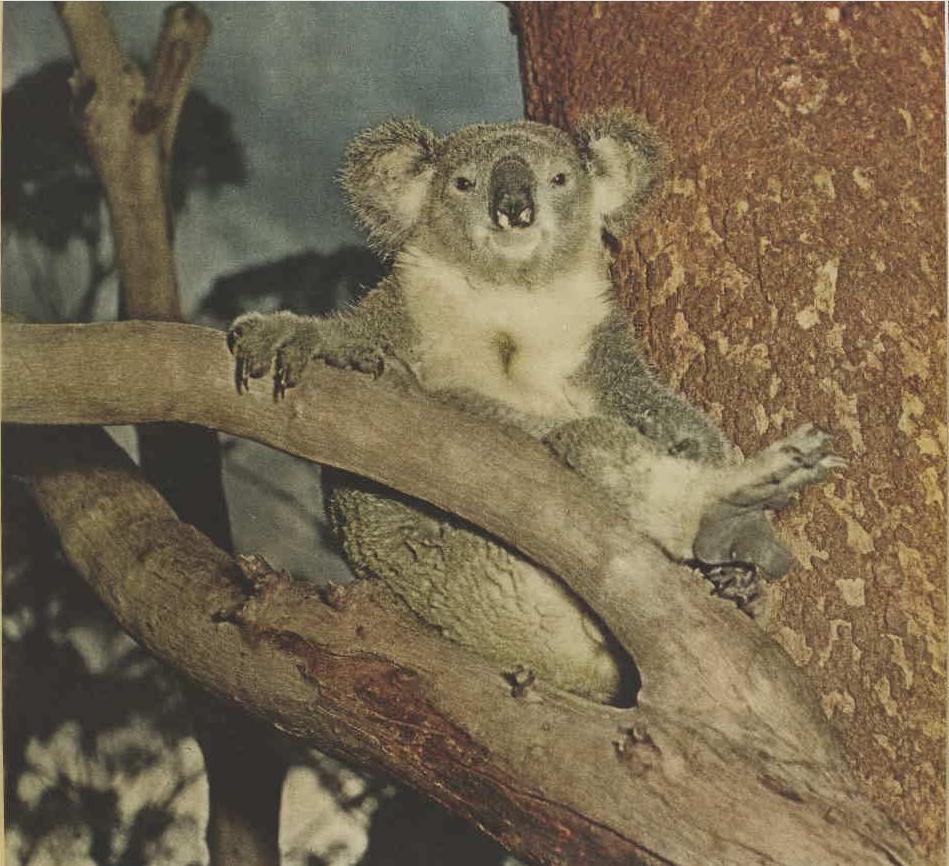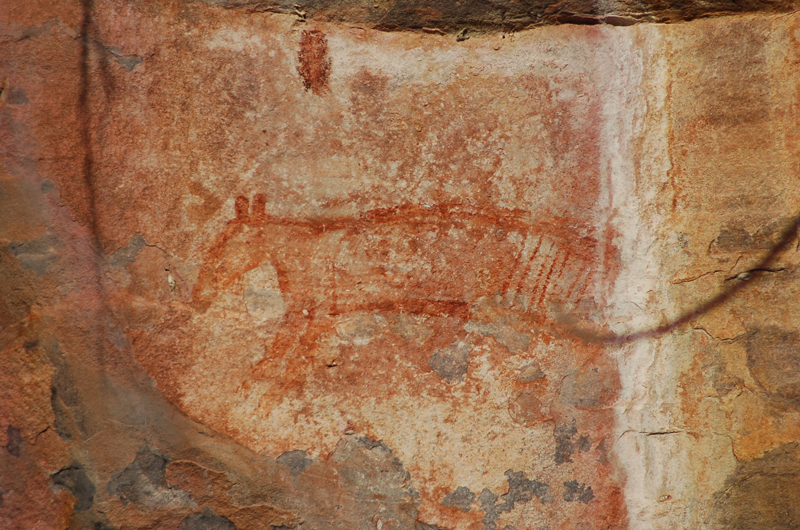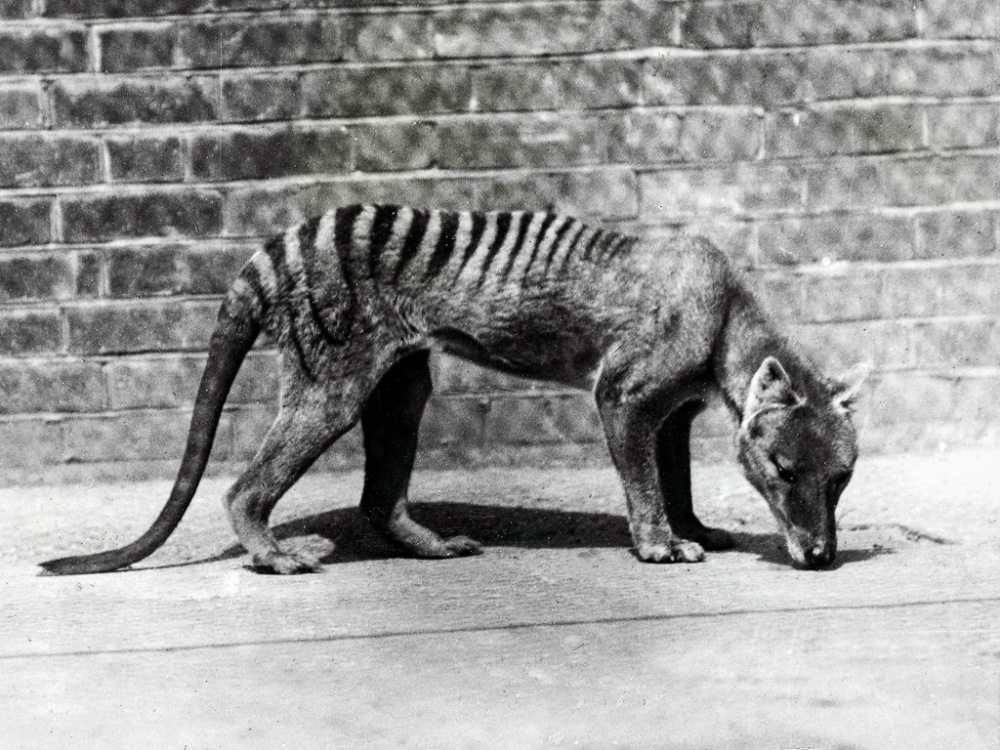The Koala's Extermination
THE koala, or native bear (Phascolarclos cinerrus), is in grave danger of extermination that is, if some-thing is not done, and speedily, too, to absolutely protect it. This lovable little animal possesses a thick, soft fur of commercial value, and many thousands are slaughtered annually and their skins exported. I use the word "slaughtered," knowing from experience — not personal, however—what a remarkably tenacious grip on life his inoffensive animal has, and when mortally wounded and it takes killing — its piteous, heartrending, and almost human cries remain in one's mind for all time.
In Queensland alone, during the year 1919 and 1920, 1,000,000 koalas were slaughtered for commercial purposes.
The following figures give some idea of the enormous number of marsupial skins exported. At one sale held last year in America the skins offered totalled 377,500, made up as follows :—
Opossums, 234,000;
ringtail opossums, 118,000:
kangaroos, 2500:
wallabies, 21,000; and
"wombats," 2000,
the so-called wombat really being koala skins.
These figures speak for themselves, and prove emphatically that drastic action on the part of the authorities responsible for the safeguarding of our native fauna is imperative. — N.W.C.
KOALA PROTECTED
The Federal Minister for Trade and Customs (Mr. Pratten) at Sydney yesterday, expressed his grave personal concern at the recent great destruction of native bears. He had caused a proclamation to be issued absolutely prohibiting export of the skins of the native bear after November 10.Any attempts to circumvent the proclamation by skin dealers or others through illicit export of skins outld be rigorously dealt with by his department throughout Australia. Mr. Pratten added that he was in complete complete sympathy with the widespread movement throughout Australia for the preservation of bird and animal fauna. While the actual preservation of fauna was under the constitution a matter of purely state concern, the Minister was determined that, as far as possible, the department which he administered would co-operate to the full to prevent the untimely devastation of these unique fauna.
The Vanishing Wombat
By "MOPOKE"
To the pioneers the "native badger" was far better known than to modern Australians, most of whom have never even seen a wombat. The quaint marsupial was much exported once, and the early settlers used It as food. "Badger hams" were the roast pig of the pioneers, and used to be smoked In the wide colonial chimneys.
The wombat looks far more like a bear than the native bear does. It also looks like a monstrous rodent, and had rodent-like teeth. But it is a pouched marsupial, one of the strangest this country possesses.
Nowadays it is shot only for "sport." though some farmers in mountain country destroy it because it is accused of blundering into and damaging fences by loosening the posts. And there are always some trappers out to get wombats for the various zoos. They usually make use of pit traps at holes in fences. The wombat is the most independent and unsociable marsupial in Australia, found quite alone except In the mating season. It cares little for dog or dingo, and remains strangely unafraid when attacked. One swipe of the sharp, curved claws will send any ordinary dog howling, and an un-armed man will have to jump aside as the heavy creature comes straight at him.
The animal is remarkably thickset, with very thick and short legs. It has been called a "furry pig." The neck is very short, the tail rudimentary. The stocky solid body is about a yard in length.
The wombat is now restricted to unfrequented places, and it likes rough mountain gullies best. As the twilight deepens and silence settles over the land, it comes shuffling out on to the grassy flats for its night feeding. Now and then, if with a mate, it will give a brief growling grunt of reassurance. It loves to crop paspalum, but eats all sorts of grasses, and will stop to scratch up small shrubs here and there to get at the succulent roots. It also chews the inner bark of certain plants.
If set upon by men and dogs it will make straight for the great burrow, trundling along with surprising speed, moving strangely low over the ground on account of the stumpy legs. At such a time no human in the way will make it swerve aside.
It breeds always in winter, and for the burrow it likes to choose a spot far down a slope. It begins operations by taking a crouching attitude like an immense mouse; then It starts to tear out grassy clods, throwing them backwards down the incline into the creek bed. It seems a clumsy worker, but is marvellously efficient. It is the biggest of all the burrowers, fashioned in every way for digging. The front limbs are extremely stout and strong, and each broad and solid front foot Is armed with five strong digging claws, which protrude from the fur. A tunnel will run into the bank for about 15 feet or so, and at the end is widened into a chamber. There a dry and cosy nest, or, rather, carpet, is made, bits of bark being carried in from the slopes outside.
Tunnelling often begins in early June, and there in the warm and secure darkness a single young one is born before the end of July. Wombats usually come out to their feeding before darkness sets in, but on dull and rainy days they will be abroad much earlier. They seem to judge by the light alone. The lumpy baby is left behind till about December, when it first comes out and sees the great world for itself. The burrow entrance is easy to find, but it is no joke trying to dig one out. I have seen picks and shovels noisily at work for half an hour among the stiff clay and boulders, after which the job was given up as quite hopeless, only about six feet of the hillside then being laboriously hacked away.
People often plug up an entrance securely with logs and large stones, but next morning the fugitive will invariably be found to have dug Its way out with ease. In such a case a burrow Is always abandoned by the wombat.
The animal will probably become totally extinct, for everyone wants to shoot one. The skins seem to be useless, but just because the animal is now rare it is hunted as a curiosity. The psychology of the alleged "sportsman" is hard to fathom.
Wombats are being driven farther and farther afield, and the senseless slaughter continues.
It seems strange that they have never reached the northern parts of Australia, especially as they seem to dislike very cold weather. They were thought to be confined to the southern States till as late as 1900, when a new species was found in South Queensland, just over the border. This is the Queensland hairy-nosed wombat, one of the largest. The common kind belongs to Victoria, New' South Wales, and South Australia. It has very harsh hair, while the Queenslander has a silky coat. South Australia has also a species of its own, but there are no wombats in West Australia. Two other kinds occur off the mainland — the Tasmanian wombat and a small species found on a couple of islands in Bass Strait.
All are at the mercy of the thoughtless gunman, in spite of Government protection, and Australians of the future will never have the opportunity of seeing this strange marsupial.
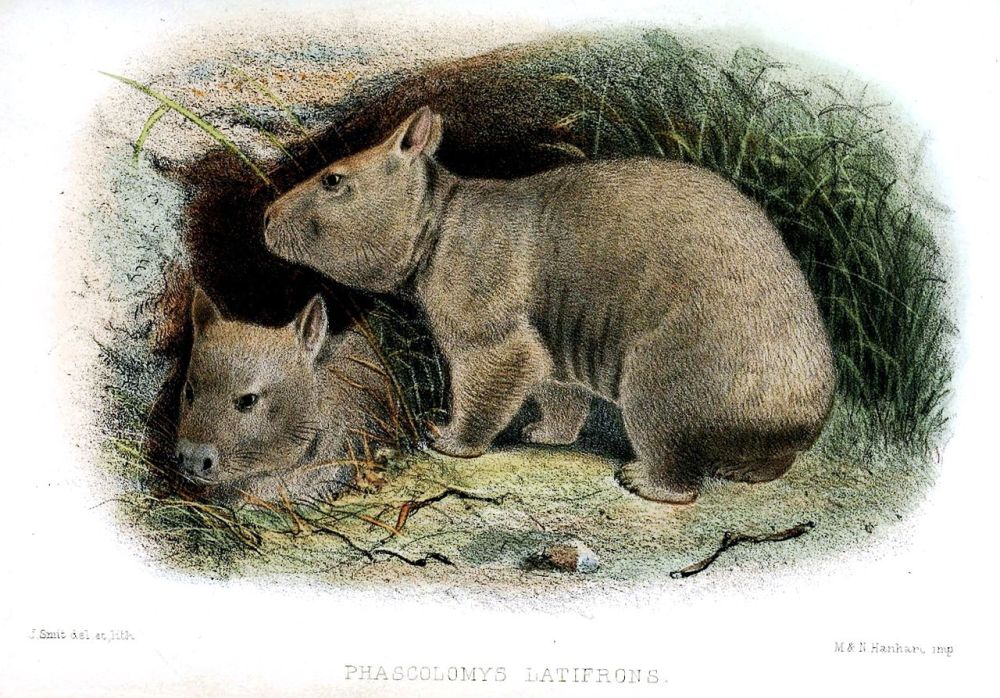
Phascolomys latifrons = Lasiorhinus latifrons- Illustration by Joseph Wolf - Proceedings of the Zoological Society of London 1865
"KOALA AN ASSET." Plea for Preservation.
Two of five koalas injured in bush fires at Newport on Saturday have died from exhaustion. The three bears which remain are being treated at Koala Park. The secretary of the Koala Club of Australia. Mr. Frank L. Edwards, said yesterday that, during 1937 and 1938, the club had participated in the rescue of nine maimed bears from the Pittwater district.
"At this rate," he added, "the animals will vanish from that district in three or four years. As there are not 200 of them left in New South Wales, this is a tragedy. Koalas, one of our best animal assets, are allowed to stray to their rapid destruction, as in the Pittwater district while the law requires that other stock be paddocked.
"If we lose them." Mr Edwards added, "twould be of little use to talk of stocking up with koalas from elsewhere. The States are already refusing to transfer koalas and, In any case, the Queensland and Victorian native bear's are different types from ours."
"KOALA AN ASSET.". (1939, January 17). The Sydney Morning Herald (NSW : 1842 - 1954), p. 10. Retrieved from http://nla.gov.au/nla.news-article27976025
THE KOALA DISAPPEARS!
The following article by Mr. Burnet is the most vital which "The Sunday Sun" has published for many months. It is so important that it replaces on this page to-day Tom Glover's cartoon and the Editor's "Out of The Basket" column.
IT tells a story of destruction; something which has meant a lot to Australia. It brings forcibly before the eyes of 300,000 readers and the Government the problem which has to be faced. "The Sunday Sun" is heartily in support of any scheme to retain Koala Park.
By NOEL BURNET, Of Koala Park
In 1927 the Queensland Government declared an "open season" for Native Bears resulting in the slaughter of 584,738 innocent Koalas, whose skins were exported mainly to America for making up fine leather goods — ladies' bags, belts and shoes. Now, strangely enough, few American visitors would fail to give everything they possess to take back to the States a real live "Teddy-bear," but, alas, that cannot be. As a national asset, the importance of the Koala is constantly being drummed into us by almost every visitor to our shores. What is a grateful country doing to save the Native Bear with that "plaintive face" which has so completely "sold" Australia to the rest of the world?
The answer is — NOTHING. Travel interests are not alone in the almost ruthless exploitation of the Native Bear, yet nothing is done this end — except talk — for the benefit of this dying genus.
'Gumleaf" was the name of that fascinating little Bear with boot-button eyes whose photograph was used by the National Travel Association to produce an oversea poster. He was allowed to die — without a sob by anybody — because money was not available for medical research upon an eye complaint he was suffering, although n number of Sydney doctors voluntarily assisted. So passed the most charming Koala ever seen at Koala Park.
Dead in Hospital
ANOTHER famous Bear, "Taringa," who made the world smile, died on the Park hospital floor (with six others) from pneumonia — erstwhile dreaded scourge of Koalas — because the taxation commissioner had dragged the last penny from Park funds, leaving me without cash or credit to buy sufficient oxygen or supplies to fight the disease. The State has since relieved the Park from commercial basis taxation, but the Federal Government, after making some concessions, will continue to tax my work as a business enterprise. Nothing, however, can replace seven beautiful native Australians whose pelts are now deteriorating in poor preservative because I cannot obtain from the Customs Department pure spirit free of excise duty (55s per gallon) as other institutions can.
Following
Following nine years of personal labor on behalf of the Koala, and assisted by several capable scientists, I say definitely, that failing immediate practical measures for its retention, this strange creature will be a thing of the past within a few years. Little is being done elsewhere. The Government is slow to realise that in this State, 30 years of "office chair" administration of the Birds and Animals Protection Act has seen the Koala reduced to vanishing point. Koala Park, in face of many difficulties, has made some attempt to save the Koala. It has lifted it from obscurity and despair; secured for it public affection the world over, but now Koala Park itself is dying. Known but to a few only, this institution has for years struggled on — -now only to a point of collapse. ' I volunteered to save a dying race. To this end six years ago a suitable sanctuary was secured, fenced, equipped, thousands of eucalyptus trees planted, a staff was trained, and considerable biological research has since been conducted. Measure;: have been evolved to control several Koala diseases by preventive methods, and I demonstrated for the first time that the Koala can be successfully bred in modified captivity — all this at a 'cost of something like £10,000. Healthy stock being difficult to acquire, I had to he satisfied in many cases with degenerate stock and endeavor to build up from that. Having accomplished this much, the work is collapsing because of lack of capital, also lack of material, viz. Bears. It is impossible for me to provide for the future and pay now. Every penny I possess has been spent in the cause. Capital cannot be raised as few tangible assets have been created. Plainly, the Park revenue is insufficient to .maintain it owing to limited . means of obtaining funds. Transport interests alone, who convey people to the Park, jointly, gain three times more revenue than the Park itself; lliey carve off the lion's share, leaving me the crumbs. Mr. T. H. Kelly, the Park benefactor, has done more than his share and is not expected to do more.
Awful Discrepancy
FURTHER, there is no heed for, nor can I meet competition in Bears from Taronga Park, where the discrepancy over some years between the birth and death rates is dreadful. Feeding the Koalas within the Park is a problem, and now costs over £600 a year. Daily, suitable food in the bush becomes scarcer. Landowners are being paid to save their gum-trees for reserve food supply. No trees have been planted in the Park for 3 years; now, trees are dying in drought conditions because I cannot afford to, water, them. Preventive vaccines, obtained by years of. careful research at heavy cost, have been lost- as payment for incubator cultures cannot be met. ' " The laboratory is closed. Depreciation presents its ugly head— fences arc in disrepair and the grounds shabby; half my staff is on the dole. Koala Park is sick, but fortunately the health of the Bears is excellent. ; I have begged on several occasions for a little relief labor for small works to improve' the conditions for Bears,' and to permit my oversea visitors access to the animals in distant parts of the Park, but gangs of men chipping up grass and weeds along roads all over the district is apparently far more important.
Premier Knows
FIFTEEN months ago, I placed the plight of Koala Park before the Premier, who, at my request, promptly appointed an investigation committee.- Following investigations, I understand, a majority report in very favorable terms was submitted —to which Cabinet, later, gave sympathetic consideration. Measures for relief were approved. Those referred back to the Premier's Department were put into effect immediately; that saved the Park collapsing all the time. Those provisions in the hands of the Chief Secretary's Department have dragged on for nine weary months without materialising. Fortunes have, ere this, been spent upon expeditions to the lands of the extinct to recover a few ugly bones or fragments of an ancient egg; taxpayers in other countries to-day are forking-out" millions for restoration and conservation; here, large sums can be outlayed for embellishments lo local and national parks of doubtful tourist interest, whilst the National Travel Association spends thousands of pounds of public and private money to "push" the Koala oversea — and the quaint Native Bear perishes at our very door. Koala Park, the background of this publicity, is unable to present the national pet under congenial conditions or, carry on its rehabilitation work. Oversea visitors come, having been "sold" the Koala by enterprising shipping lines over and over again. The Bears are mauled; these visitors do not realise that handling is the worst possible thing for a dying primitive race, nor do they understand my difficulties, but they expect me to justify their trip to Australia at the equivalent of n lean tip to a cabin steward. Everywhere, hundreds of thousands of people have keenly watched this Park grow up from a mere hobby, but its inhabitants belong to the nation. It is high time, therefore, that the public know of the sad plight of Australia's own "Teddy-bear,"
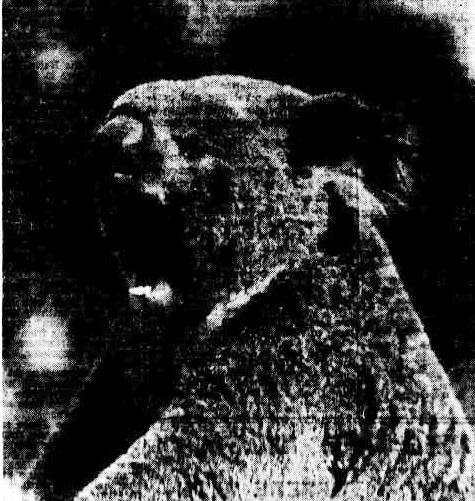
" Taringa " — the Koala that made the world smile-and perished for lack of attention.
A lorry load of 3000 Koala skins obtained, by a party of men in the Clermont district ( Queensland ) in thirty days.
Map showing (left) approximate general former distribution of the Koala, and (right) present distribution.
THE KOALA DISAPPEARS! (1936, September 13). The Sun (Sydney, NSW : 1910 - 1954), p. 4. Retrieved from http://nla.gov.au/nla.news-article230016599
Decades on:
PROTECT KOALA FROM EXTINCTION
Koalas have been proclaimed "rare fauna" under the New South Wales Fauna Protection Act.
Announcing this, the Chief Secretary, Mr. Clive Evatt said:
This course appears to be the only way to protect the koala from extinction. The koala population in New South Wales has fallen to 5000. Yet in 1924, 2,000,000 koala skins were exported from the eastern States."
The declaration of animals or birds as "rare fauna" provides, in addition to the usual penalty of a fine not exceeding £50 for taking or killing a protected bird or animal, a term of imprisonment not exceeding six months.
"Take or kill" as defined in the Act includes hunting, shooting, killing, poisoning, netting, soaring, pursuing, disturbing, or injuring, Mr. Evatt explained.
Koala Facing Extinction
By N. L. ROBERTS.
A recent proclamation of koalas as rare fauna provides a maximum penalty of £50 for taking or killing this quaint and lovable marsupial, and also makes the offender liable to imprisonment for a period not exceeding six months.
While such a stringent protective measure is welcome, it will not be easy to save the koala from extinction in some States where it was once plentiful, because its numbers have been depleted to danger point by destruction of habitat, commercial exploitation, bush fires. and disease. Estimates of the koala population in New South Wales range from 100 to 500. There is general agreement that the prospects of survival in Victoria are slight. Queensland is the stronghold of this little "bear," but even there the effect of trapping nearly three million for their skins in three years is apparent. It is now considered rare in some districts where it was once common. The koala was established on Phillip Island, Victoria, with Government aid--£3000 was granted towards enclosing the sanctuary with a fireproof fence. It was once common in south-eastern South Australia, but is not found in West Australia and Tasmania. Wherever the koala exists in its natural state, it is strictly protected by law. Better still, it is even more strongly protected by public opinion, for the memory of wrongs and cruelties inflicted upon this defenceless creature in the past, the diffusion of knowledge concerning its harmless habits and droll ways, and the prominence given to it in caricature and photographic and other newspaper features, have created for it a strong national sentiment. No zoo in Australia can keep a koala without a special licence. There is an absolute ban against export.
SETTLEMENT in a new land inevitably exacts a heavy toll of animal life. The koala has suffered severely because it is highly specialised for living in trees. It is also a very selective feeder. Only about 20 out of some hundreds of different kinds of eucalypts are suitable for its diet. The clearing of large areas of forest obviously reduces available food supplies. Being a slow-moving animal, too, the koala is at a sad disadvantage when bushfires sweep the country. Many thousands have been trapped by flames and burnt to death. Thousands more have succumbed to mysterious disease. Experience has proved that the koala is highly susceptible to lung, ophthalmic and intestinal troubles.
Australia was a vast sanctuary tor all kinds of animal oddities even long before the primitive aborigines made it their home. Its isolation preserved forms of life that had once been widely distributed, and excluded the later and more familiar types.When When the first white settlers arrived, they were naturally puzzled by the many strange animals 'they saw. They frequently solved the problem of naming them by prefixing the word "native" to any new animal that bore some kind of resemblance to another animal already well known to them. Thus the koala became a "native" hear. Even scientists found difficulty in classifying some of our unique animals. The argument whether the koala is related more closely to the wombat than the opossum has not been finally settled yet.
MEANWHILE, till the experts can settle the point, the koala has been put in a family all by itself the family known by the rather awe-inspiring title of phascolaretidac, which comprises two Greek words meaning "pouched bear." Although it is not a bear, the superficial resemblance has been an advantage, inviting the popular designation "Teddy Bear," and all the sentiment it invokes.
But why "koala?" And pronounce it "ko-la" if you want to be fussily correct! In 1798, the native name of "cullawine" was mentioned in an anonymous account of a journey. In 1802, there was another reference to "portions of a monkey" called by the natives "colo." In 1803, it was "koolah," this name being varied to "koala," an aboriginal word believed to mean "no drink." It is applicable to this quaint little creature, which, rarely, if ever, drinks.
